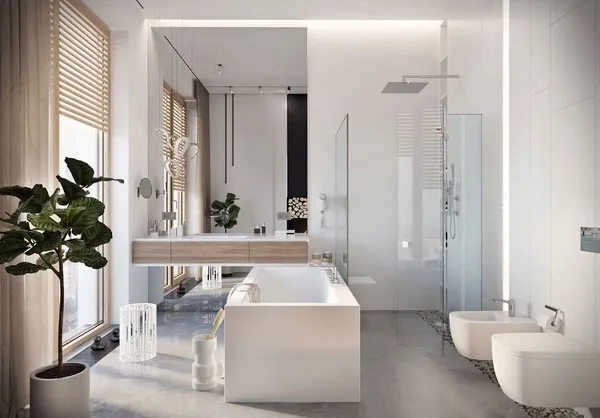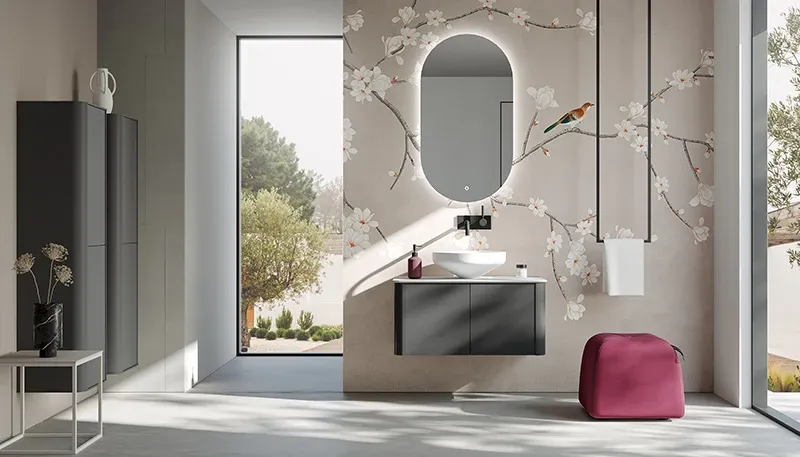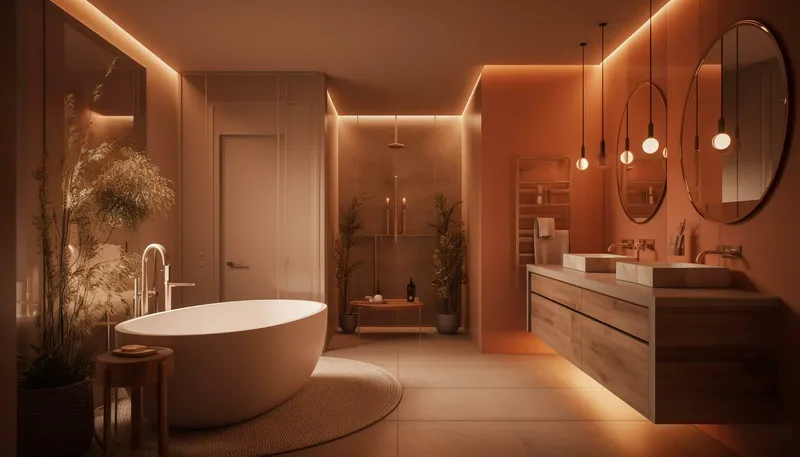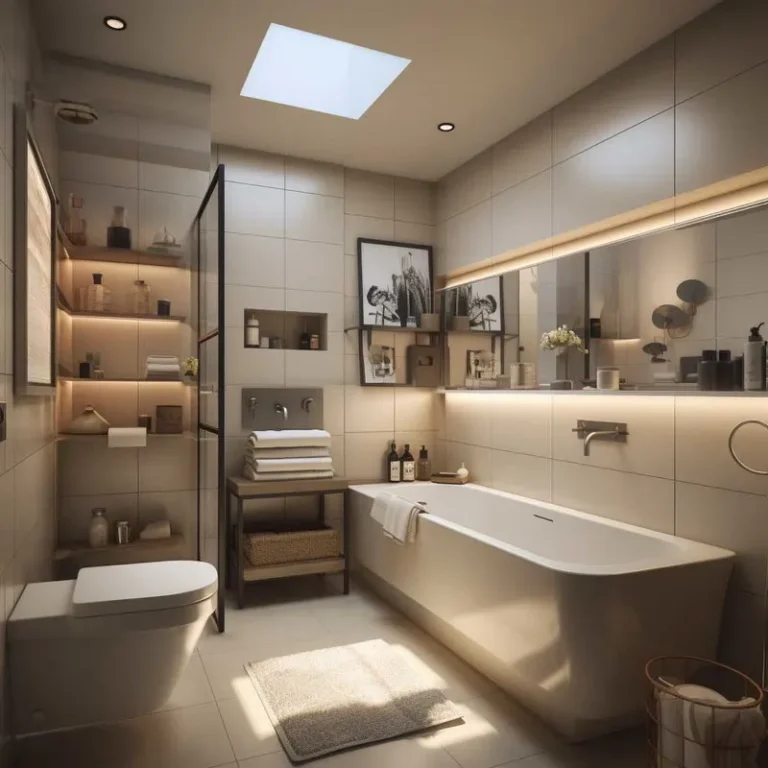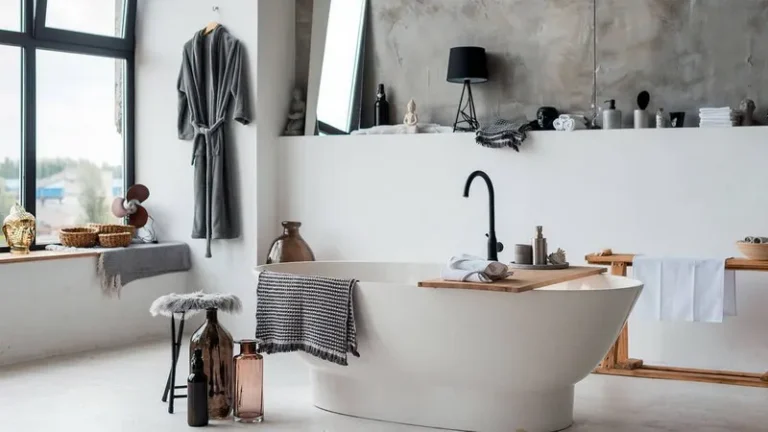Bathroom Trends 2025: Modern Designs, Smart Tech & Stylish Makeovers
Last Updated on September 14, 2024 by Mutiara
As we step into 2025, the bathroom is no longer just a functional space; it’s a sanctuary for relaxation, wellness, and rejuvenation. Bathroom design trends for this year are all about creating environments that blend luxury with sustainability, comfort with cutting-edge technology. From smart innovations that make your daily routine more efficient to natural materials that bring warmth and serenity to your space, the modern bathroom is evolving into a personal retreat. In this guide, we’ll explore the top bathroom trends for 2025, covering everything from eco-friendly designs and spa-like features to the latest in tile patterns and vanities. Whether you’re planning a full renovation or simply looking to upgrade a few elements, these trends will inspire you to create a stylish, functional, and future-forward bathroom.
1. Sustainable Bathroom Design Ideas for 2025
As the world continues to prioritize sustainability, bathroom design is no exception to the eco-conscious movement. In 2025, homeowners and designers alike are seeking ways to make their bathrooms more environmentally friendly, integrating sustainable materials and water-saving technologies without sacrificing style. The trend is clear: sustainability isn’t just a buzzword, it’s a necessity in modern design.
Eco-Friendly Materials for Bathroom Design
One of the most prominent trends in sustainable bathroom design for 2025 is the use of eco-friendly materials. More designers are choosing materials that are not only aesthetically pleasing but also responsibly sourced and renewable. Here are some of the top choices:
- Recycled Tiles: Recycled glass and ceramic tiles are becoming increasingly popular for bathroom flooring and walls. These tiles give homeowners the opportunity to reduce waste by using materials that have been repurposed. Recycled tiles come in a variety of colors and patterns, making them a versatile option for any design style.
- Bamboo Flooring: Bamboo has long been celebrated for its rapid growth and renewability, and in 2025, it’s a top choice for eco-friendly flooring. Bamboo is durable, water-resistant, and adds a natural warmth to the bathroom space. It’s a sustainable alternative to traditional hardwoods, providing a modern look while being kind to the environment.
- Low-VOC Paints: In line with the push for healthier homes, low-VOC (volatile organic compounds) paints are in high demand. These paints release fewer harmful chemicals into the air, improving indoor air quality. For bathroom walls, where humidity levels fluctuate, low-VOC paints offer a long-lasting, safe, and environmentally conscious option.
- Natural Stone and Quartz: Countertops made from natural stone or quartz not only bring elegance to a bathroom but also have the advantage of being highly durable and long-lasting. Sourced responsibly, these materials reduce the need for frequent replacements and minimize environmental impact.
Water Conservation in the Bathroom
In 2025, water conservation remains a major focus in sustainable bathroom design. The bathroom is one of the most water-intensive areas of a home, but with smart technology and innovative fixtures, it’s easier than ever to reduce water consumption without compromising on comfort or convenience. Here’s how:
- Low-Flow Fixtures: Low-flow faucets and showerheads have come a long way in recent years. Where they were once associated with weak water pressure, today’s models are designed to provide a powerful experience while significantly reducing water usage. These fixtures can cut water consumption by up to 50%, making them an essential feature in any eco-conscious bathroom.
- Dual-Flush Toilets: The dual-flush toilet, which allows users to choose between a low-volume flush for liquid waste and a higher-volume flush for solid waste, continues to be a popular choice in 2025. These toilets save thousands of gallons of water per household each year, making them a simple but effective way to promote water conservation.
- Smart Showers: One of the most exciting developments in water-saving technology is the smart shower. These systems can be programmed to preheat water to a desired temperature and pause the flow once the water is ready, preventing unnecessary water waste. Some models also track water usage, helping homeowners stay mindful of their consumption.
Natural Lighting and Energy Efficiency
Another key aspect of sustainable bathroom design is the integration of natural light and energy-efficient fixtures. In 2025, designers are focusing on reducing the need for artificial lighting during the day, as well as incorporating energy-saving technologies that lessen the environmental footprint of the bathroom.
- Skylights and Windows: Natural light not only creates a more inviting and comfortable bathroom environment but also reduces the need for artificial lighting during daylight hours. Skylights and large, strategically placed windows are becoming more common, bringing in ample light while maintaining privacy. Natural lighting can also help reduce mold and mildew growth by keeping the space dry and well-ventilated.
- LED Lighting: When artificial lighting is necessary, energy-efficient LED fixtures are the go-to choice. LEDs use significantly less electricity than traditional incandescent bulbs and have a much longer lifespan. In 2025, homeowners are increasingly opting for LED strip lighting around mirrors, under cabinets, and in shower niches to create a modern, efficient lighting scheme.
2. Best Smart Bathroom Technology for 2025
As we move further into the digital age, smart home technology is revolutionizing every room in the house, including the bathroom. In 2025, smart bathrooms are more than just a luxury—they’re a standard for tech-savvy homeowners. From touchless fixtures to personalized, voice-activated systems, the bathroom of the future is all about convenience, efficiency, and comfort.
Smart Mirrors: More Than a Reflection
The humble bathroom mirror has undergone a high-tech transformation in recent years, and in 2025, smart mirrors are taking center stage. These mirrors do more than reflect your image—they provide valuable information and entertainment while you get ready for the day.
- Voice Activation: Many smart mirrors come equipped with voice assistants like Alexa or Google Assistant, allowing users to control lighting, play music, or even check the weather, all while getting ready. Some models also include built-in speakers and touchscreens, making it easy to multitask in the bathroom.
- Temperature and Lighting Control: Smart mirrors often integrate with other smart devices in the home, allowing for centralized control of bathroom temperature, lighting, and humidity levels. You can adjust the brightness or warmth of the lights with a simple voice command, creating a more personalized and comfortable bathroom experience.
Touchless Fixtures: The New Normal
The COVID-19 pandemic accelerated the adoption of touchless technology in public spaces, and now it’s making its way into homes. In 2025, touchless faucets, soap dispensers, and even toilets are becoming standard in many modern bathrooms. These fixtures not only improve hygiene but also contribute to water conservation by reducing unnecessary use.
- Touchless Faucets: Designed with motion sensors, touchless faucets activate only when needed, helping to conserve water. Many models also come with temperature presets, so you can have the perfect water temperature without adjusting it manually.
- Smart Toilets: The rise of smart toilets in 2025 is a game-changer for bathroom technology. These high-tech fixtures often include features like heated seats, self-cleaning functions, automatic lid operation, and bidet attachments. Some models even offer health monitoring systems that analyze urine for early signs of illness.
3. Luxury Spa Bathroom Trends for 2025
The concept of the bathroom as a sanctuary continues to evolve in 2025, with homeowners seeking to create a spa-like retreat within their homes. Luxury spa bathrooms combine indulgence with functionality, offering an escape from the stresses of daily life while incorporating cutting-edge design features and materials. Here are some of the top trends transforming everyday bathrooms into luxurious, spa-like environments.
Soaking Tubs and Steam Showers
One of the most sought-after features in luxury spa bathrooms is the soaking tub. These deep, freestanding tubs, often placed in a central spot within the bathroom, are designed for long, relaxing baths. In 2025, soaking tubs come in a variety of materials, including stone, copper, and acrylic, offering both aesthetic appeal and comfort.
- Freestanding Tubs: Freestanding soaking tubs remain popular due to their sculptural beauty and ability to create a focal point in the bathroom. Models in sleek, modern shapes or classic, clawfoot designs allow for a personalized spa-like experience.
- Steam Showers: Steam showers have also become a staple in luxury bathrooms. These enclosed showers generate steam to create a sauna-like experience, which helps with relaxation, improves circulation, and detoxifies the body. In 2025, steam showers come with advanced features like aromatherapy, chromotherapy lighting, and digital controls that allow you to customize the steam temperature and duration.
Heated Floors and Towel Warmers
Nothing says luxury like stepping out of a bath or shower onto a warm floor. Radiant floor heating systems have become a standard feature in high-end bathrooms, providing even warmth throughout the space and enhancing the overall comfort of the room. Heated floors are particularly popular in colder climates, but they’re becoming increasingly common in homes across all regions due to their energy efficiency and comfort.
- Radiant Heating: In-floor radiant heating is a popular choice for its energy-saving benefits and the luxurious feel it brings to the bathroom. Many systems can be connected to a smart thermostat, allowing for precise control over the temperature and timing.
- Towel Warmers: Another luxurious addition to spa bathrooms is the towel warmer. These sleek racks not only warm towels but can also be used to gently heat robes, adding an extra touch of indulgence to the bathing experience.
Natural Materials and Calming Aesthetics
The visual design of luxury spa bathrooms in 2025 is all about creating a calming, natural atmosphere. This is achieved through the use of materials like natural stone, wood, and textured finishes, as well as soft, neutral color palettes that evoke tranquility.
- Stone and Wood: Natural materials such as marble, travertine, and wood bring a sense of organic beauty to the bathroom. Stone walls, wood vanities, and natural textures help to create a serene, spa-like ambiance.
- Neutral Colors: Calming color palettes featuring shades of white, beige, gray, and soft pastels continue to be popular in luxury spa bathrooms. These tones create a peaceful environment and make the space feel larger and more open.
4. Minimalist Bathroom Design Ideas for 2025
Minimalism is a major trend across all areas of home design, and bathrooms are no exception. In 2025, minimalist bathroom designs focus on simplicity, functionality, and clean lines, creating spaces that are both modern and tranquil. By eliminating unnecessary clutter and focusing on essential design elements, minimalist bathrooms offer a sense of calm and order.
Clean Lines and Open Spaces
At the heart of minimalist bathroom design is the concept of clean lines and open, uncluttered spaces. This means choosing fixtures and fittings that are sleek and streamlined, with an emphasis on functionality over ornamentation.
- Floating Vanities: One of the most popular features in minimalist bathrooms is the floating vanity. Mounted to the wall, these vanities create the illusion of more space by leaving the floor clear. They often incorporate hidden storage to keep clutter out of sight, maintaining the clean, streamlined look.
- Walk-In Showers: Another staple of minimalist bathroom design is the walk-in shower. These showers often feature frameless glass enclosures, large-format tiles, and minimal hardware, contributing to the overall sense of openness and simplicity.
Neutral Color Palettes
In keeping with the minimalist aesthetic, color schemes in 2025 minimalist bathrooms tend to be neutral and understated. Soft whites, beiges, grays, and blacks dominate, creating a timeless and sophisticated look.
- Monochrome Palettes: Many minimalist bathrooms stick to a monochrome color scheme, using different shades of a single color to create depth and interest. This approach helps maintain the sleek and uncluttered feel while still adding visual appeal.
Maximizing Storage with Minimalism
One of the challenges of minimalist bathroom design is ensuring there’s enough storage to keep the space tidy without cluttering the aesthetic. In 2025, clever storage solutions are key to achieving this balance.
- Hidden Storage: Built-in shelving, recessed cabinets, and storage niches are commonly used in minimalist bathrooms to keep toiletries and personal items out of sight. These hidden storage options ensure that the bathroom remains functional without compromising the minimalist look.
- Open Shelving: For those who want to display a few curated items, open shelving is a popular choice. Minimalist open shelves made from materials like wood or glass can hold towels, plants, or decorative pieces, adding a touch of personality while maintaining the clean aesthetic.
5. Best Bathroom Tiles for 2025: Trends in Patterns and Materials
Bathroom tiles are a defining element in any bathroom design, and in 2025, tile trends are shifting towards bold patterns, natural materials, and large formats. Whether you’re designing a statement wall or covering the floor, the right tile choice can set the tone for the entire bathroom.
Geometric and Bold Patterns
Tiles with geometric patterns are a big trend in 2025, as homeowners look for ways to add visual interest to their bathrooms without overwhelming the space. These patterns often feature clean lines and bold shapes, creating a modern and stylish aesthetic.
- Hexagonal Tiles: Hexagonal tiles, also known as honeycomb tiles, are one of the most popular choices in 2025. Their unique shape creates a dynamic, textured look that works well on both walls and floors.
- Chevron and Herringbone Patterns: Chevron and herringbone patterns are also trending, particularly for backsplashes and shower walls. These patterns add a sense of movement and elegance to the space, especially when used with bold, contrasting colors.
Natural Materials: Marble and Terrazzo
In keeping with the trend towards natural, organic materials, marble and terrazzo tiles are making a big comeback in 2025. These materials bring a luxurious, timeless feel to the bathroom, with each piece offering its own unique texture and color variations.
- Marble Tiles: Marble tiles are synonymous with luxury, and they continue to be a popular choice in high-end bathroom designs. Whether used on floors, walls, or countertops, marble adds an elegant, classic touch to the space.
- Terrazzo: Terrazzo, a composite material made from chips of marble, quartz, granite, or glass, is another trendy option for 2025. Its speckled appearance creates a playful, modern look that works well in both minimalist and maximalist designs.
Large-Format Tiles
Another key trend in bathroom tile design for 2025 is the use of large-format tiles. These oversized tiles create a seamless, contemporary look, with fewer grout lines giving the bathroom a cleaner, more spacious appearance.
- Porcelain and Stone Slabs: Large porcelain or natural stone slabs are being used on both floors and walls to create a sleek, high-end aesthetic. These tiles not only look luxurious but are also easier to clean and maintain due to the reduced grout lines.
By incorporating bold patterns, natural materials, and large-format tiles, bathrooms in 2025 are making a strong design statement while maintaining a modern, cohesive look.
6. Freestanding Bathtubs vs. Built-In: Which is Trending in 2025?
Bathtubs remain a central element of bathroom design, but in 2025, the debate continues between the sleek, aesthetic appeal of freestanding bathtubs and the practicality of built-in tubs. Each has its advantages, and choosing the right one depends on your space, style, and needs. Here’s how both types of bathtubs are trending in 2025.
Freestanding Bathtubs: The Focal Point of Modern Bathrooms
Freestanding bathtubs have been a popular choice for luxury bathrooms for several years, and this trend shows no signs of slowing down in 2025. Their sculptural, standalone design creates a striking visual focal point, making them ideal for homeowners looking to add a touch of elegance and sophistication to their space.
- Aesthetic Appeal: Freestanding tubs are available in a range of styles, from modern, minimalist designs to vintage-inspired clawfoot tubs. Their versatility allows them to fit into any design scheme, whether it’s contemporary or traditional.
- Flexibility in Placement: One of the major advantages of freestanding tubs is their flexibility in placement. Unlike built-in tubs, which are usually confined to corners or alcoves, freestanding tubs can be positioned anywhere in the bathroom, making them an ideal choice for large, open spaces.
- Material Options: In 2025, freestanding bathtubs come in a variety of materials, including acrylic, cast iron, stone, and copper. This allows homeowners to choose a material that not only complements their design style but also enhances the bathing experience through heat retention and durability.
Built-In Bathtubs: Practicality and Efficiency
While freestanding bathtubs steal the spotlight, built-in bathtubs still hold strong in 2025, especially in homes where space and functionality are priorities. Built-in tubs are typically enclosed on three sides and integrated into the bathroom’s layout, making them a practical choice for smaller bathrooms.
- Space-Saving Design: Built-in bathtubs are often favored for their efficient use of space. They can be incorporated into alcoves or under windows, leaving more floor space open for other elements in the bathroom. This makes them a smart choice for bathrooms with limited space.
- Versatility in Functionality: Many built-in tubs offer additional features, such as integrated storage or shelving around the tub deck, providing a practical solution for storing toiletries, towels, or décor. They are also more likely to be combined with a shower, offering a versatile two-in-one bathing solution.
- Easier to Install: Built-in bathtubs are generally easier and less expensive to install than freestanding tubs, as they don’t require special plumbing or flooring reinforcement. This makes them a popular choice for renovations or bathrooms where the layout is already fixed.
7. Top Bathroom Vanity Trends for 2025
Vanities are the centerpiece of bathroom design, providing both functionality and style. In 2025, the focus is on clean lines, innovative materials, and maximizing storage, all while creating a space that feels both modern and luxurious. Here are the top bathroom vanity trends for 2025 that are shaping stylish and functional bathroom designs.
Floating Vanities for a Sleek Look
Floating vanities, which are mounted to the wall with no visible legs or support, continue to dominate bathroom designs in 2025. Their sleek, minimalist look helps create the illusion of more space, making them ideal for both small and large bathrooms.
- Sleek and Modern: The minimalist design of floating vanities gives bathrooms a clean and modern aesthetic. They are often paired with contemporary hardware, vessel sinks, and LED lighting to enhance their modern appeal.
- Maximizing Floor Space: Because floating vanities don’t touch the floor, they make a bathroom feel larger and more open. This also makes cleaning easier, as there are no legs or supports to get in the way.
Double Vanities for Shared Spaces
In 2025, double vanities are a popular choice for master bathrooms or shared bathrooms. They provide ample counter space and storage for two people, making them both functional and stylish.
- Customizable Design: Double vanities come in a variety of designs, from traditional side-by-side sinks to more creative layouts where each sink is on opposite sides of the vanity. This allows homeowners to customize their vanity to fit their space and personal preferences.
- Luxury and Functionality: Double vanities not only offer more counter space but also add a sense of luxury to the bathroom. When combined with quartz or marble countertops, they become a striking focal point that enhances both the function and aesthetics of the space.
Natural Materials and Bold Finishes
Natural materials are making their way into vanity design in 2025, with wood, stone, and metal finishes becoming increasingly popular. These materials bring a sense of warmth and texture to the bathroom, balancing modern design with natural beauty.
- Wood Vanities: Wooden vanities, particularly those made from reclaimed or sustainably sourced wood, are trending for their eco-friendly and rustic appeal. These vanities add warmth and texture to the bathroom, making them a perfect choice for both modern and traditional designs.
- Bold Metal Accents: Brass, gold, and matte black hardware are in vogue for bathroom vanities in 2025. These bold finishes provide a striking contrast against natural wood or stone, creating a modern, high-end look.
8. Heated Bathroom Floors: Is Radiant Heating Worth It in 2025?
Radiant heating systems for bathroom floors have become a must-have luxury feature in 2025. Offering both comfort and energy efficiency, heated floors are an attractive addition to modern bathrooms. But are they worth the investment? Here’s why radiant heating is trending and the benefits it offers.
Comfort and Luxury
The primary appeal of heated floors is the comfort they provide. There’s nothing quite like stepping out of a shower onto a warm floor, especially on cold mornings. This sense of luxury is why radiant heating systems are so popular in high-end bathroom designs.
- Even Heating: Unlike forced-air heating systems that can leave cold spots, radiant heating provides even warmth throughout the floor. This makes bathrooms feel more comfortable and eliminates the need for additional space heaters or rugs.
- Perfect for Colder Climates: In areas with colder winters, heated floors can make a big difference in how comfortable a bathroom feels year-round. They provide consistent warmth without using much energy, making them both luxurious and practical.
Energy Efficiency
In addition to comfort, radiant heating is also an energy-efficient option for heating bathrooms. Since it heats the floor directly, rather than warming the air, it uses less energy to achieve the same level of comfort as traditional heating systems.
- Lower Energy Bills: Radiant floor heating systems are more energy-efficient than conventional heating methods, which can result in lower energy bills over time. They are especially effective in small spaces like bathrooms, where a small amount of heat goes a long way.
- Smart Thermostat Integration: Many modern radiant heating systems are compatible with smart thermostats, allowing homeowners to control the temperature of their bathroom floors remotely or set schedules to ensure the floor is warm when needed. This adds another layer of convenience and efficiency.
9. Bathroom Lighting Trends 2025: What’s In and What’s Out
Lighting plays a crucial role in bathroom design, affecting both functionality and ambiance. In 2025, bathroom lighting trends focus on layered lighting, energy efficiency, and smart technology. Here’s a look at what’s in and what’s out in bathroom lighting design for 2025.
Layered Lighting for Function and Ambiance
In 2025, the trend is all about layered lighting, which involves using different types of lighting to create a balanced and functional space. This approach combines ambient, task, and accent lighting to ensure the bathroom is well-lit for all activities while also providing a relaxing atmosphere.
- Ambient Lighting: Ambient lighting, such as recessed ceiling lights or flush-mount fixtures, provides general illumination for the bathroom. In 2025, LED fixtures are the top choice for ambient lighting due to their energy efficiency and modern appearance.
- Task Lighting: Task lighting, particularly around mirrors, is essential for activities like shaving or applying makeup. In 2025, backlit mirrors and LED strip lighting around vanities are trending for their sleek design and ability to reduce shadows.
- Accent Lighting: Accent lighting, such as under-cabinet or toe-kick lighting, adds a layer of sophistication to the bathroom. It creates a soft glow that enhances the overall ambiance of the space.
Natural Light and Skylights
Maximizing natural light is a key trend for 2025 bathroom designs. Skylights and large windows are being incorporated into bathroom renovations to flood the space with natural light, reducing the need for artificial lighting during the day.
- Skylights: Skylights are particularly popular in bathrooms where privacy is a concern, as they allow natural light to enter without the need for large windows. They also make the space feel larger and more open.
- Energy Efficiency: Natural light reduces the reliance on artificial lighting, helping to lower energy consumption and create a more eco-friendly bathroom design.
Conclusion
The bathroom trends of 2025 reflect a desire for comfort, luxury, and sustainability. From freestanding bathtubs and smart technology to natural materials and energy-efficient heating systems, homeowners are embracing innovations that enhance both the functionality and aesthetics of their bathrooms. Whether you’re renovating a small guest bathroom or designing a spa-like retreat, these trends offer inspiration for creating a modern, stylish, and practical space that’s perfect for the future.
